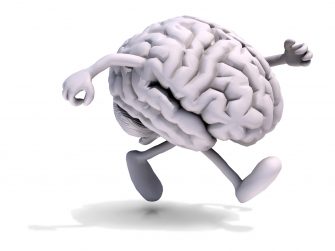Exercise: It’s on the “tip of the tongue”
 It is not unusual to periodically have moments when you “know” that you know a word, but can’t quite get it out. People often use the expression “it’s on the tip pf my tongue!” in frustration. Scientists recognize this as a cognitive lapse, albeit a temporary lapse.
It is not unusual to periodically have moments when you “know” that you know a word, but can’t quite get it out. People often use the expression “it’s on the tip pf my tongue!” in frustration. Scientists recognize this as a cognitive lapse, albeit a temporary lapse.
While tip-of-the-tongue states occur at all ages, this tends to befall older adults more frequently. It is documented to be among the most frequent cognitive failures in healthy older adults.1 Additionally, it leads to increased stress levels as older adults worry it may be a signal of a larger memory issue. However, this is not the case. Speaking is a two-part process. The brain must first determine word meaning, then the pronunciation of that word.2 A tip-of-the tongue state occurs when there is a disruption in that process.
Studies have demonstrated that aerobic fitness benefits cognitive control, executive functioning, visuo-spatial memory, learning and processing speed.3,4 However, no previous studies examined the relationship between aerobic fitness and language functioning.
To explore this phenomenon researchers looked into the relationship between aerobic fitness and ‘tip-of-the-tongue’ experiences. What they found may surprise you. There is actually a very strong association between the two.
The study, titled “Higher physical fitness levels are associated with less language decline in healthy ageing”, recently published in Scientific Reports “hypothesized that there would be a positive relationship between aerobic fitness levels and word finding abilities in our sample of healthy older adults, independent of age and vocabulary size.”5 They measured oxygen uptake from a graded exercise test in order to rate aerobic fitness.
Participants were asked to perform language tasks such as read definitions of words, then think of and speak that word. Regardless of age, tip-of-the-tongue events occurred less often with shorter target words. Additionally, those with a larger personal vocabulary had fewer incidence. As expected the events occurred more with increased age.
In their findings, they noted a trend that the more aerobically fit the older adults were, the less likely they were to experience a tip-of-the-tongue state. This relationship continued regardless of the participant’s age or vocabulary size. To further investigate the impact on language cognition, they divided the participants into 2 groups: a high-fit older adults and a low-fit older adults. When compared side by side there was no significant difference in the age, vocabulary size or education levels. The high-fit group had lower occurrence of tip-of-the-tongue events than the low-fit older adults.
While the specific how and why of brain structure and function are difficult to measure, aerobic fitness has been associated with multiple benefits for the brain such as improved blood flow6 and “greater grey matter volume.”7
Researchers for the study concluded “results suggest that higher aerobic fitness levels are associated with better word production skills in healthy older adults.” In time, additional research may reveal exactly how aerobic fitness affects brain structure and function. Still, this supports incorporating increased physical fitness into a routine for healthy aging and optimal brain function now and for years to come.
Regular exercise is a way of life for many people to keep their health in check. There is a tremendous range of activities available making it possible for every one of every age to find something that is suitable to their interest, health status, ability and budget. Research shows a “measurable increase” in aerobic fitness may be achieved in as little as 6 weeks.8
It’s never too late to start moving! Even if you begin with walking to your mailbox, in time, you may be walking miles. The important thing is to find something that is accessible, enjoyable and safe for you to do. Once you begin, you can build on that initial activity as you gain strength and endurance.
If you have questions or concerns about beginning an activity, talk to your chiropractor on your next visit. What is an appropriate activity for one person may not be good for another. Your chiropractor can discuss your current health concerns and goals with you, proper biomechanics of activities you enjoy and help you determine a good starting point. You may also be given stretches or exercises to help strengthen your body, improve flexibility and prevent injury. If you don’t have a chiropractor, you can click here to find a TCA member doctor near you.
REFERENCES:
1 Ossher, L., Flegal, K. E. & Lustig, C. Everyday memory errors in older adults. Aging, Neuropsychology, and Cognition 20, 220–242 (2013).
2 Levelt, W. J. Spoken word production: A theory of lexical access. Proceedings of the National Academy of Sciences 98, 13464–13471 (2001).
3 Colcombe, S. J. & Kramer, A. F. Fitness effects on the cognitive function of older adults: A meta-analytic study. Psychological Science 14, 125–130, https://doi.org/10.1111/1467-9280.t01-1-01430 (2003).
4 Guiney, H. & Machado, L. Benefits of regular aerobic exercise for executive functioning in healthy populations. Psychonomic bulletin & review 20, 73–86 (2013).
5 K. Segaert, S. J. E. Lucas, C. V. Burley, P. Segaert, A. E. Milner, M. Ryan & L. Wheeldon “Higher physical fitness levels are associated with less language decline in healthy ageing”, Scientific Reports (2018). DOI: 10.1038/s41598-018-24972-1
6 Bailey, D. M. et al. Elevated aerobic fitness sustained throughout the adult lifespan is associated with improved cerebral hemodynamics. Stroke 44, 3235–3238 (2013).
7 Erickson, K. I., Leckie, R. L. & Weinstein, A. M. Physical activity, fitness, and gray matter volume. Neurobiology of aging 35, S20–S28 (2014).
8 Thomas, A. G. et al. Multi-modal characterization of rapid anterior hippocampal volume increase associated with aerobic exercise. Neuroimage 131, 162–170 (2016).